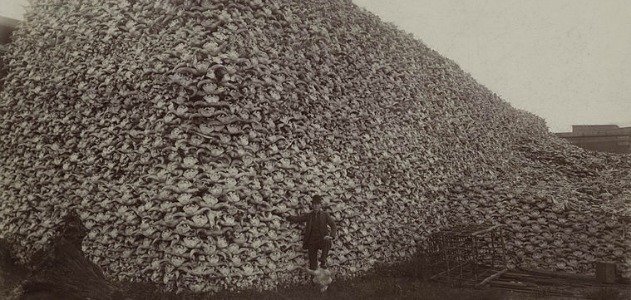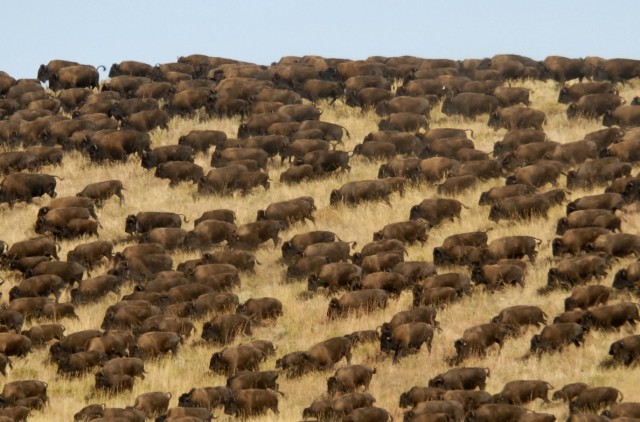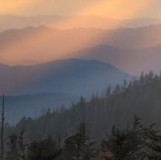 In an all-too-common example of revisionist history, NPR’s story of the bison becoming the “National Mammal” recounted the near-extinction of the species during American expansion while completely failing to mention that the buffalo slaughter was a deliberate military strategy in the ethnic cleansing of Native Americans from the Plains. In fact, NPR even listed subsistence hunting by Indians as a contributing factor in the demise of the buffalo.
In an all-too-common example of revisionist history, NPR’s story of the bison becoming the “National Mammal” recounted the near-extinction of the species during American expansion while completely failing to mention that the buffalo slaughter was a deliberate military strategy in the ethnic cleansing of Native Americans from the Plains. In fact, NPR even listed subsistence hunting by Indians as a contributing factor in the demise of the buffalo.
In 1868, General Sherman wrote to General Sheridan, “As long as Buffalo are up on the Republican [River] the Indians will go there. I think it would be wise to invite all the sportsmen of England and America there this fall for a Grand Buffalo hunt, and make one grand sweep of them all.”
A year later, the Army Navy Journal reported, “General Sherman remarked, in conversation the other day, that the quickest way to compel the Indians to settle down to civilized life was to send ten regiments of soldiers to the plains, with orders to shoot buffaloes until they became too scarce to support the redskins.”
 Sheridan followed the advice, providing guns, a military escort, a marching band, a team of cooks, and an entire train to guide Grand Duke Alexis, son of the Russian Czar, for a week of shooting. Colonel George Armstrong Custer led the party. For fun they pretended the buffalo were Indians, charging them and shooting from horseback. They slaughtered hundreds and left the carcasses.
Sheridan followed the advice, providing guns, a military escort, a marching band, a team of cooks, and an entire train to guide Grand Duke Alexis, son of the Russian Czar, for a week of shooting. Colonel George Armstrong Custer led the party. For fun they pretended the buffalo were Indians, charging them and shooting from horseback. They slaughtered hundreds and left the carcasses.
In the meantime, tanneries learned to convert buffalo hides into commercial leather. They paid up to three dollars per hide. Market hunters, with US Army encouragement, brought the slaughter to apocalyptic proportions. They surrounded water holes and killed over five thousand buffalo a day.

Market hunter with buffalo skulls.
It came to a head in 1873. When Congress debated a bill to protect the buffalo, General Sheridan addressed a Joint Session, “For the sake of lasting peace, let them kill, skin and sell until the buffaloes are exterminated.”
The Secretary of the Interior added, “The civilization of the Indian is impossible while the buffalo remains upon the plains.”
In 1873, an estimated 1,508,658 buffalo were killed by whites, 130,000 by Indians. Lieutenant Colonel Richard Dodge, stationed in Kansas, wrote, “Where there were myriads of buffalo the year before, there were now myriads of carcasses. The air was foul with a sickening stench, and the vast plain, which only a short twelvemonth before teemed with animal life, was a dead, solitary, putrid desert.”
The same year, a poet named Brewster Higley penned these words:
Oh, give me a home where the Buffalo roam
Where the Deer and the Antelope play;
Where seldom is heard a discouraging word,
And the sky is not cloudy all day.
Five years later, in 1878, the agent at Fort Sill allowed the Comanches to leave the reservation for a buffalo hunt. The Natives were shocked to find nothing but bleached bones on the prairie.
In 1882, Dodge reflected on the state of the Natives: “Now everything is gone, and they are reduced to the condition of paupers, without food, shelter, clothing, or any of those necessaries of life which came from the buffalo.”
By 1902, the last wild herd of buffalo had 23 individuals.
NPR called the buffalo a “symbol of past majesty”, invoking the myth of a wild empty continent. In fact, the buffalo meant life to the Natives and merely a tool of genocide to the US military. NPR closed its story with a moving orchestral rendition of Home on the Range.



Right: no empty continent. Thanks for a compelling article
Reblogged this on Cynthia Coleman Emery's Blog and commented:
A terrific response to the Tatonka Story this week
Reblogged this on Novel.
Thank you for this articulate response to a story that should have spoken truth and didn’t.